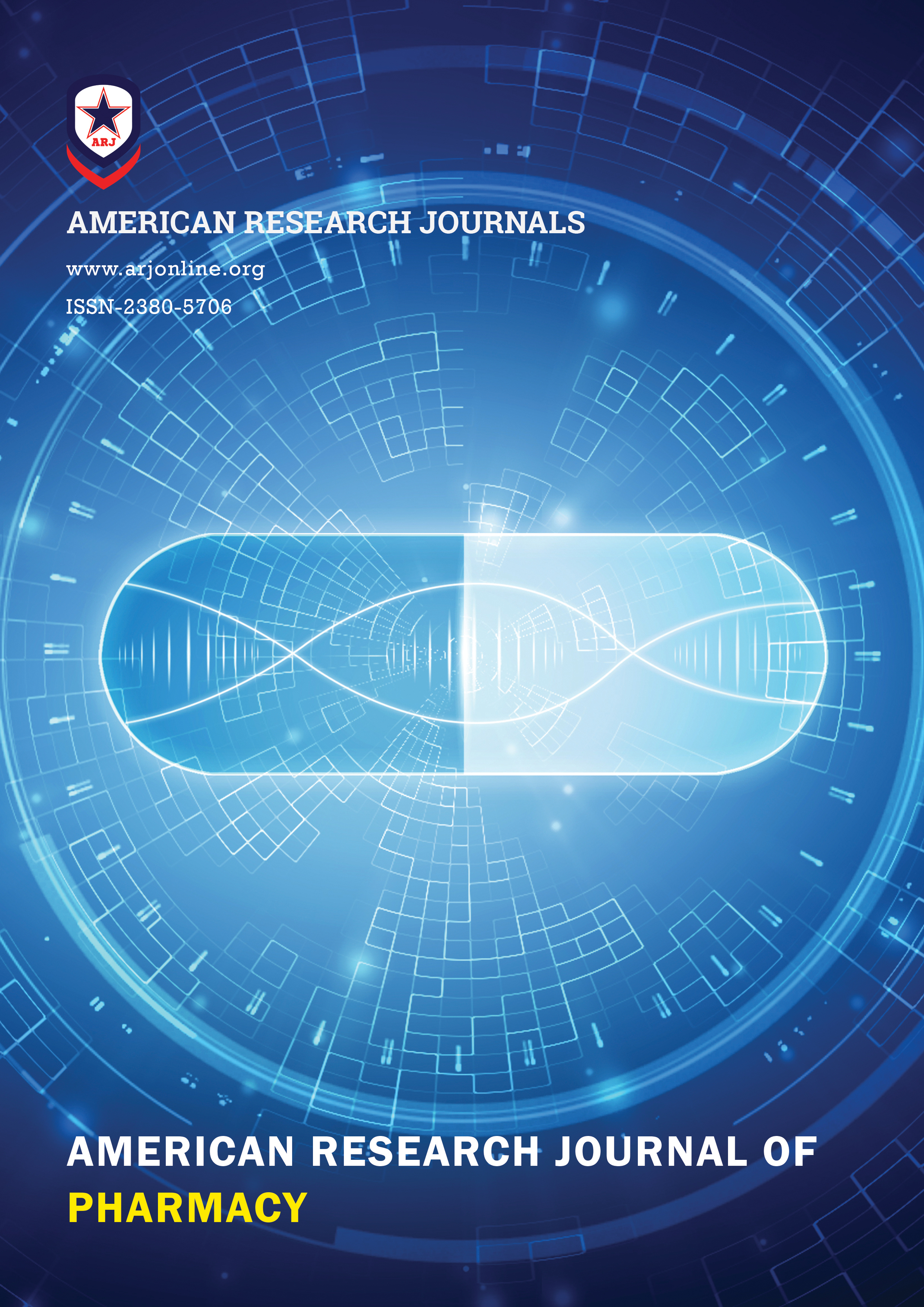Assessment of Components, Antibacterial and Antioxidant Effects of Vernonia Amygdalina Del.
Pdf : 18 Views Download
Citation: Sy Duong Quy, Trinh Tang Le Quynh, Linh Nguyen Thi Nhat, et al., “Assessment of Components, Antibacterial and Antioxidant Effects of Vernonia Amygdalina Del.”, American Research Journal of Pharmacy, Vol 6, no. 1, 2021, pp. 1-6
Copyright Sy Duong Quy, Trinh Tang Le Quynh, Linh Nguyen Thi Nhat, et al., This is an open access article distributed under the Creative Commons Attribution License, which permits unrestricted use, distribution, and reproduction in any medium, provided the original work is properly cited.
Abstract:
Vernonia amygdalina Del. - Asteraceae family, is used traditionally to treat inflammation, pain, fever and cancer. This study aimed to determine the bioactive composition of leaf extracts of Vernonia amygdalina Del. for evaluating the antibacterial and anti-oxidant effects of these extracts. Analysis of the active ingredients in the aqueous extracts of Vernonia amygdalina leaves showed the presence of pharmaceutical substances such as: tannins, flavonoids, saponins, alkaloid, phenol, phytalate and oxalate. The results of determining the antibacterial activity of fresh and dried leaf extracts with concentrations of 100%, 50%, 25%, 12,5%, and 7,5% showed that Staphylococcus aureus and Escherichia coli are very sensitive to these extracts, especially the aqueous extracts. The antioxidant activity of Vernonia amygdalina leaf and stem extracts at different concentrations was determined by the DPPH and β-carotene-linoleic acid method compared with BHA, BHT, and quercetin. A positive correlation of radical scavenging activity (p value < 0.05) was observed in all the extracts from Vernonia amygdalina by their electron transfer or hydrogen donating ability.
Keywords: antibacteria, antibio, antioxydant, component analysis, Vernonia amygdalina
Description:
INSTRUCTION
The world is facing many health challenges due to environmental pollution, climate change and humanitarian crisis leading to outbreaks of diseases, the increase of drugresistant microorganisms,... Besides, the environment of living, working, studying and the development of science and technology makes people less and less physically active, causing a strong impact on human health. The increased incidence of obesity, stress, metabolic disorders, or premature aging is the cause of many diseases such as infections, cancer, diabetes and aging. The use of plants and natural products is beneficial in protecting against damage caused by oxidative stress, / since they are less toxic, compared to synthetic compounds in dosages. their optimal protection. Synthetic antioxidants such as butylated hydroxyl anisole (BHA) and butylated hydroxyl toluene (BHT) are harmful to the liver [22]. Therefore, the selection of natural products to protect health, against pathogens is a prerequisite for the process of discovering new materials for use as medicine. Bitter Leaf is in Asteraceae family with the scientific name (Vernonia amygdalina Del. = Gynura procumbens (Lour.) Merr.), people in many parts of the world, especially countries in Africa such as Nigeria, Cameroon, Congo ... is used to treat many different common diseases such as pain treatment, hypertension, dyslipidemia, diabetes mellitus, cancer prevention ... with simple usage as a daily vegetable. Many studies of scientists around the world have published the effects of the Vernonia amygdalina extract such as antioxidant, anti-inflammatory, antiemetic effects of acetone extract [1], breast anti-cancer [14]. Therefore, the research conducted investigating the analgesic and anti-inflammatory effects of Bitter Leaf Vernonia amygdalina Del. are collected at.
MATERIALS AND METHODS
Plant Preparation
Vernonia amygdalina Del.- ASTERACEAE was collected from the medicinal garden of Lam Dong Medical college at 16 Ngo Quyen, Da Lat city, Lam Đong - province in Vietnam. After collecting, the plant was removed damaged leaves and stems, washed carefully, and cut separately into three parts (leaves, stems and rhizomes), then, dried at 45o C for 48 / hours, then, ground into a coarse powder sifting through sieve of 35 mm pore size mesh.
Extraction of Vernonia Amygdalina Powder
200 g of coarse powder of each part (leaves, stems and rhizomes) was macerated in 1 L methanol in each the absorbed exhausted bottle with cotton on the bottom for 48 hours before filtering. The powder was covered under a filter paper, then glass marbles, and macerated by pouring slowly methanol high 5 or 6 cm into the bottle. The resulting filtrate was evaporated and concentrated to a paste dryness using a water bath set at 45°C to obtain the extract then was stored in the refrigerator below 10°C until required for further analysis.
The methanol extract of Vernonia amygdalina powder was ranged from strong polarity to less polar by liquid-liquid extraction techniques: dissolve the total extract into Methanol in the ratio of 1:1/2 (1 ml extract: 0.5 ml methanol); then pour water into with a ratio of 1:2 (1 ml extract: 2 ml water). This fraction was shaked in turn with solvents of increasing polarity solutions (Diethyl ether, Ethyl acetate, n-Butanol) until no more dissolved matter mixing in the solvent, then switch to a more polar solvent. After collecting and evaporating the fractions to remove the solvent, 4 extracts (diethyl ether, ethyl acetate, n-butanol, and aqueous extract) were obtained respectively.
Preliminary Component Analysis of Vernonia Amygdalina
The fractions of diethyl ether extract, ethyl acetate, n-butanol, and aqueous extract /were analyzed to determine substances which have positive results in the preliminary survey. [4] To determine alkaloid: Dissolve each fraction in 4 ml hydrochloric acid 1% solution, then, divide the acid solution into 4 small test tubes, and determine alkaloid by the reagents (Mayer, Bouchardat, and Dragendorff). [4] The result of Mayer reagents is that test tube change to white precipitate and light-yellow liquid; of Bouchardat reagents is that test tube change to red- brown precipitate; and the result of Dragendorff reagents is that test tube change to redorange precipitate.
To determine flavonoid group: Using the reaction with H2 SO4 , NaOH, and FeCl3 to determine flavon, flavonol, isoflavon, chalcon, auron, leucoantocyanidin in the ethanol extract and other extracts, and the Cyanidin reaction of Wilstatter to find the presence of flavon, flavanon, flavonol, flavanonol, xanthon in the methanol extract. [4]
To determine polyphenol group: Using the Liebermann reaction to determine anthraquinon in NaOH 10% solution. [4]
To determine coumarin: Dissolve each extract in 2 ml alcohol 70%, then divide the solution into two test tubes, and add to the first tube 0.5 ml KOH 10% and the second an equal amount of distilled water, finally, heat them in a water bath for 2 minutes. After the solution is cool, the reaction result was observed under 365 nm ultraviolet light.[4]
To determine tannin: Add 5 drops of gelatin into 2 mL of each extract, and stir them, compared with the certificate tube containing the filtrate and the tube containing the reagent (gelatin-salt solution). If there is a white cotton precipitate, there is tannin.[4]
To determine the terpenoid group use Liebermann - Bourchard reaction; to determine the steroid – triterpenoid group use the Rosenthler reaction or Carr – Price reaction; to detect steroid using Salkowski reaction, and to determine saponin group by foaming test and Fontan – Kaudel test.[4]
Thin-layer chromatography: The presence of main components in each extracts was evaluated was by chemical method with general reagent and TLC (Thin-layer chromatography) method. TLC was performed on sheets coated with layer of silica gel, and dried in room temperature for 30 mins. The solvent system I [ethyl acetate: methanol: distilled water (100:8:5)], and the solvent system II [Chloroform: methanol: distilled water (65:35:10)] were used. 10 µM of each extract was spotted on the silica plates. Next, the plates were run in a chromatographic chamber for about 20 mins, saturated by 100 mL of solvent systems. Finally, they were visualized at 254 nm and 365 nm under UV, and by FeCl3 reagent. [4]
Antimicrobial Activity Analysis of Vernonia Amygdalina Extracts
The Antimicrobial activity of Vernonia amygdalina extracts was determined by the diffusion method in agar or liquid medium. Each indicator bacteria was cultured in a suitable media at 37°C for 24 hours. The diluted bacterial solution (100 μl) was added into each media, and then 100 μl of each extractor sterile paper wells (6 mm in diameter) containing each extract was put into them. Sterile distilled water is a control. The Petri plates or test tubes were incubated at 37.0 ± 0.10°C for 24 hours. The diameter of the inhibitory zone (mm) or turbidity bacteria was measured.
Antioxidant Activity Analysis of Vernonia Amygdalina Extracts
The antioxidant activity of the Vernonia amygdalina extracts
(n-hexan, ethyl acetate, ethanol, and aqueous extract) was
firstly determined by DPPH (1,1- diphenyl-2-picrylhydrazyl)
on a thin plate of silica gel F254 (Merck); the extract was
diluted in methanol 95%, put on the plate, the solvent
system was n-hexane: ethyl acetate (8:2), DPPH reagent
(0.001% by weight/volume) were mixed when used. Then, the antioxidant activity of the extract on free radicals was
compared to BHA (butylated hydroxyanisole), BHT (butylated
hydroxytoluene) and quercetin, measured in hydrogenincreased antioxidant activity, used as the color indicator of
DPPH or β-carotene-linoleic. Each 7.5, 8.75, 10 and 11.25 ml
of Vernonia amygdalina extracts and each 0.25, 0.5, and 0.75
ml of BHT (in methanol) were placed in different tubes. A
mixture of 5 ml of 0.5 mM DPPH or β-carotene-linoleic was
prepared for all tubes; after 30 minutes of incubating at
room temperature (22-24°C), the absorbance was measured
at 517 nm with a spectrophotometer and 1 ml of methanol
mixed with 5 ml of 0.5 mM DPPH or β-carotene-linoleic
served as blank. [8]



















